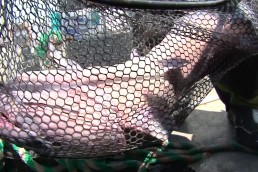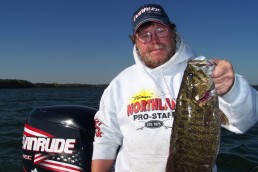Why You Should Never ‘Lift’ a Fish
SHARE THIS POST
If you fish correctly, any large fish should be netted because your setup necessitates use of the net. If you fish like the yahoos on television, you “tuna-hoist” all your fish by lifting the line.
The yank and hoist method is used by tournament anglers, so many copy it. Just like a regular person copying the actions of a pro athlete—you should never lift your fish like this.
The reason is simple: If you are fishing to catch the most—and largest—fish, you need to be stealthy. A heavy line capable of lifting big fish from the water is easily detected, and far too thick. Fish can feel the line and treat it as a “non-food” item in their mouths. When fish encounter non-food items, they spit. They fire water in reverse to clear out the weed, rock, twig or pebble. Then, they sort their food. Fish sort constantly all day, every day. They eat food that swims, crawls or hatches around weeds, mud and gravel. Fish are excellent at ejecting non-food, then taking in the food.
Some use terms like garbage fish or bottom feeders—these fish are adept at working around debris and weeds to find tiny bits of live, delicious food. No fish eat garbage, and no fish like garbage—they want fresh food. Sometimes that worm is hidden under 1/4 inch of mud, or beneath a weed. Fish, in their regular day, sort through this and get the food. All fish do it.
To them, your fishing line is just another item to sort through, so having thin line keeps the fish on your hook longer, because thicker line will be discovered and spat out much faster than thin line. When I fish for panfish, trout, perch or crappies I choose thin lines like a .11-mm diameter leader. To give you a comparison, if you use a 6-pound Stren, that is .22-mm fishing line, and twice as thick as you need. The fishing line I use has a breaking strength of 2.2 pounds. This line lands fish up to 13 pounds in almost every situation, so long as I use proper technique. It also results in hundred of takes, because it is thin and flexible.
I use a net. I also use a very fine light steel hook. The combination of a tiny, fine steel hook, with a thin leader line is light and stealthy. The line functions to flex (and easily bend) when the fish “vacuums” the bait. This flexing is very important because your line will literally travel farther into the fish’s mouth if the line flexes. On thick lines, the line doesn’t bend when sucked in and ends up not traveling into the mouth or worse. Thick lines are ignored, ejected, result in missed strikes and are 100 percent the cause of lesser catches and skunks. A “skunk” is far too popular a term, as way too many anglers know a day with no fish is called “getting skunked.”
Also note that in July, water temperatures around the U.S. and Canada hit their peak. Fish get sluggish in warm water, and won’t feed with the strong bite.
Don’t make your first mistake in picking fishing equipment by buying leaders and snelled hooks off the shelf. Modern leader lines are freakishly thick, with insufficient hooks. Eagle Claw makes leaders with lines thick enough to tow a boat, and the hooks are cheap wire hooks that murder bait on contact.
I use live bait on the fine steel hook so it stays alive longer. This system offers the best and easiest food offering for fish. Simply put, the bait looks the best, generates the most “takes,” and the fish can vacuum it up without much effort. Making the bait easier to take means nearly every fish will take that bait in with no pause, no effort. This means maximum bites, takes and hook-ups.
With this system, not only do I catch many fish, but I also hook into some giants. One secret to this system is that fish normally inhale in their food at about 10 percent of their max power. This is how they feed. They feed light.
You can visit the Chicago Fishing School’s YouTube channel and see how fish feed in our “Learn to Fish” section. Watch the graph showing the fish feeding at “regular power.” Once you see the secret of fish feeding, and then adjust your gear, a whole new world will open up to you. Rig up light, and watch what happens.
My light line is only the last 12 inches of my rig. This is ultra-light, super-flexible and undetectable to the fish’s eyes and mouth. In clear water it is fluorocarbon line. This line is clearer than water and it hides your rig. The rest of my line is one notch stronger. If I am casting the 2-pound line, I then spool up 4-pound line on the reel (if I’m using a reel).
Are you enjoying this post?
You can be among the first to get the latest info on where to go, what to use and how to use it!
The steel hooks are strong enough to battle the fish in the water, but not strong enough to lift the fish from the water. I hook-up fish that are between 5 to 15 pounds because of my setup, and since I have to play these big fish on the light wire hooks (and thin line), I land them in the net. Big hook plus big bait does not equal big fish.
Hooks I use are between size 10 and size 16. Most all of my hooks are smaller than the nail on my little finger. This is because they have very little weight. They are easy for fish to eat, and very hard for fish to detect in their mouths. These tiny hooks keep the bait alive a lot longer than regular off-the-shelf hooks. Several brands of hook are available through my website, including ultra-fine spade end hooks. These hooks must be snelled to the line; I use a tool to snell these. I make up a card of 12 pre-snelled hooks with my special leaders. I use the Hook Ninja snelling tool. It grasps the hooks and helps me easily tie the leader snell knots. Adding a premium hook and leader line will greatly improve your catches.
Don’t forget the net—you will need it. Any species like crappies, which easily fall off the hook, or rainbow trout, I net. However, small bluegills, I swing those into my hand; however, chunky bluegills I net, if they approach a pound. If you use longer rods, which you should, simply get a longer net handle. When you land a fish, most of the fish should be lying on top of the water and only the head should be lifted off the water. Quietly glide the fish’s head over the sunken edge of the net and lift once the tail passes. Most people have horrible net skills because they are so excited to have a fish on, so they chase it with the net. Never chase the fish with the net—it is pointless.
The hooks I use are Owner Mosquito brand hooks, They are so sharp, so thin and so strong, you’ll never fish with old box store leaders again. I do use a tool to tie these on—the Snell Ninja clamps the hook, and lets you wrap a custom snell with the perfect leader line to match your fishing. You can pick up the hooks and leader tool at my online store. Stop hoisting fish and start netting tons more!
MWO
Johnny Wilkins is a float fishing expert, boat and bank-fishing competitor, and teacher who fished in three world championships with Team USA. A Chicago area native, Wilkins placed second behind his teacher Mick Thill in his best U.S. Open Championships. He is the founder of the Chicago Fishing School and has his own line of floats.
For more information…
LiveBaitTackle.com
Hook options: (left) The author’s top choice of live bait hook—an Owner Mosquito size 12 hook tied to premium .13 ice (3-pound) fishing leader line. (center) A snelled hook to 8-pound line. The company calls it a size 12, but it seems bigger. This hook barb can damage live bait because it is huge. (right) The Eagle Claw off-the-shelf hook size 10 circle. The label indicates this line is 6-pound line, but it seems heavier. Reduce your hook size and your leader line thickness to catch more big fish.
When you make your own hook and leader line, you get to pick the exact hook size and line thickness. Wrap a thin line on a snell tool that holds the hook in place and speeds up the process of wrapping a snell on the hook shank. The process takes under a minute when you warm up; make different hook leaders of different sizes and strengths to match your fishing. With clear water, use a fluorocarbon leader to hide the line. With weeds, tie a leader 2 or 4 pounds heavier to drag fish through weeds if you need to pull them out. In cold weather and extremely hot July water, use a slightly thinner line, as fish feed with less power. For hot weather, fish a .12 or .13 (3-pound) leader length, even on fish up to 13 pounds. Using a landing net as well as playing the fish on a back-winding spool, you can land massive fish on 2- and 3-pound leaders.
MWO
SHARE THIS POST
Did you enjoy this post?
You can be among the first to get the latest info on where to go, what to use and how to use it!
Johnny Wilkins
MidWest Outdoors works with more than 200 outdoor experts each year, who contribute articles based on their areas of expertise. MidWest Outdoors magazine offers more fishing and hunting articles than any other publication!



